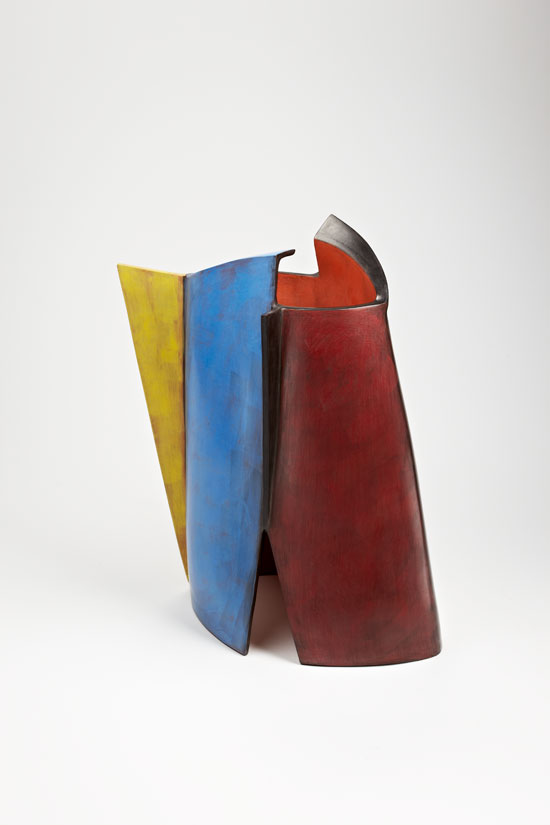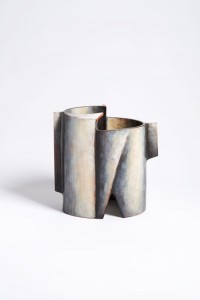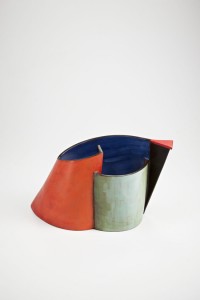"Lidya Buzio: Ceramic Sculpture – Scapes & Abstractions" at Cecilia de Torres, Ltd., 134-140 Greene Street (SoHo) New York, NY
In our New York-centric art world, the medium of ceramics tends to be relegated to a form of craft: utilitarian, functional and not ‘high art.’ "Lidya Buzio: Ceramic Sculpture – Scapes & Abstractions," on view at Cecilia de Torres Gallery in SoHo, will surely dispel this unfounded belief that fine art doesn’t include ceramics.
Opened in November 2012, the exhibition originally featured a greater number of works and earlier pieces, many of which are featured in a beautiful full-color catalogue. The current installation, though, was edited to great effect, displaying recent pieces from 2007 to 2012, with only one work from 1988.

"XV" by Lidya Buzio, 2012. Earthenware, 11 1/2 x 10 1/4 x 7 1/2 inches. Photo by Arturo Sanchez. Photo courtesy of Cecilia de Torres, Ltd., New York.
In one form or another, Lidya Buzio’s past shows up in every piece. Buzio’s artistic roots can be traced to Montevideo, Uruguay, where her family moved in 1948—the same year that she was born.
Montevideo was also the place where Joaquin Torres-Garcia had established a studio, the Taller Torres-Garcia (TTG), in 1943; about 10 years after his return from Europe. TTG was the locus of his Constructivist Universalist ideas and praxis influential to much Latin American modern and contemporary art.
The two families became neighbors and the Buzio children would frequent Torres-Garcia’s home. Although Torres-Garcia died in 1949, TTG continued under the direction of some of its older artist members. This included Torres-Garcia’s two sons, one of whom would later marry Buzio’s sister (who, in the interest of full disclosure, is the gallery director, Cecilia de Torres).
Proximity to the TTG meant full access to a holistic art aesthetic. Buzio studied painting through her late teens at TTG, and then turned to ceramics, studying with Josep Collell, who would become her closest mentor.
Buzio’s historical background comes to life in each form, line, volume and brush stroke of the ceramics on view. Her early training as a painter finds outlet in the need to create a finish in ceramic that emulates painting, a principle that Collell taught.

"VII" by Lidya Buzio, 2011. Earthenware, 16 x 14 1/4 inches. Photo by Arturo Sanchez. Photo courtesy of Cecilia de Torres, Ltd., New York.
Buzio forms her works from clay slabs that are then left to dry. After sanding, painting begins, burnishing follows and finally, the pieces are kiln-fired. The result is beautifully drafted, atmospheric architectural pieces such as the earliest one in the show, “Untitled” (1988).
After moving to New York in 1972, Buzio made the cityscape her language. I was allowed a peek into the gallery backroom to see further early works, which depict city rooftops, façades, and water towers.
The ultimate goal of creating volume with volume is achieved in vessels that are bulbous, gourd-like, or cone-shaped. Buzio creates an illusion of space that Cecilia de Torres compares to the 15th century panel “La Città Ideale.”
The vertical geometry of the architecture superimposed on a ceramic surface that sways, swivels, and swerves creates a volumetric picture space that proffers a sense of vitality highly unusual in this medium.
Such is the case with “XVI” (2007), a multifaceted vessel painted in rich tones of red, yellow, and blue and densely packed with buildings described at varying angles. Interestingly, the artist shared that her strength lies in painting on shaped, not flat, surfaces.
Illusionism and narrative pervade the work of the late '90s into early 2000s. Dealing with such representation might potentially lead to banality. Instead, Buzio excites the eye by skewing perspectives and imposing the imagery on unexpectedly shaped pots. Her renderings often recall the city and port scenes painted by Torres-Garcia, who was guided by the Classical principle of the golden section.
Buzio’s TTG background imposed a deep appreciation of Classical art and she has actively researched Italian old masters and frescoes. Her work also evokes that of Giorgio de Chirico, his metaphysical paintings from the early 1900s.

"XII" by Lidya Buzio, 2012. Earthenware, 9 1/4 x 9 1/2 x 7 inches. Photo by Arturo Sanchez. Photo courtesy of Cecilia de Torres, Ltd., New York.
“IV” (2008) reflects such references, the blue-gray piece rocking and surging perilously from a red ochre "foundation" that peeks out as under-painting and accentuates a corner slab. It has a quiet tension between solidity and immateriality, as though the piece might fall apart, the buildings topple over, but turn it and the deserted street and fronts provide a stable counterpoint. “IV” (2008) represents a transition from earlier work where architecture is applied to the ceramic vessel.
In the mid-to-late 2000s, the vessel becomes the architecture in and of itself. A move to non-objective forms begins around 2010.
While Buzio’s move to the North Fork of Long Island in the late '90s precipitated a change in subject matter from urban/industrial to coastal village/seaport, she continued with figurative themes; it would seem that being surrounded consistently by nature finally freed her from representation.
The process of dividing each piece geometrically is maintained, but the slabs of clay are allowed now to exist for themselves and the painting serves to accentuate these pure forms.
In “VIII” (2011), the brushstrokes are less impressionistic and the pigment more heavily applied. Clay slabs intersect and form an acute triangle at one end and a curved point, like a ship’s bow, on another. The work is sensuous, an aspect underlined by the color choice—in this case red ochre paired with turquoise blue—setting off the grayish white that predominates the whole.
As occurs with all the works, viewing this piece from varying angles provides distinct results: not only does the form change dramatically, the colors reveal themselves unexpectedly. “VIII” (2009) and “IV” (2010) offer similar excitement to the senses.
Beginning in 2011, the vessels become freer, with greater tension between positive and negative space; they are far less containers.
In many, Buzio applies solid hues outlined in black. While dynamically painted, angled and curved, these pieces sometimes appear rigid, perhaps due to the precise painting style. Such is the case with several works that line the wall to the right upon entering the gallery. The pieces in which Buzio diffuses the black line are more successful in transmitting movement.
“XVI” (2011) is of note, with its simple, open form and tilted angle. Dynamism in its diagonal form and orange-hued sections is tempered by the rich cobalt blue, impregnating the interior and paused by a curve of pale green. A black angle thrusts upward and punctuates the piece, otherwise this accent is limited to the edges, allowing the colors to complement each other harmoniously.
Esperanza León
BASIC FACTS: "Lidya Buzio: Ceramic Sculpture – Scapes & Abstractions" remains on view through March 9 at Cecilia de Torres, Ltd., 134-140 Greene Street (SoHo) New York, NY 10012. www.ceciliadetorres.com.
To see additional artworks in the exhibition, click here.
The original exhibition "Lidya Buzio: Painter and Sculptor of Clay" was part of Carnegie Hall's "Voices from Latin America." The citywide festival was held from Nov 8 to Dec 11, 2012. The exhibition opened on Nov 15, 2012.
Lidya Buzio is based on the North Fork of Long Island.
Additional information on the Taller Torres-Garcia is available on the gallery's website.
________________________________________
Want to know what’s happening in the Hamptons art community? How about the North Fork or NYC? Visit HamptonsArtHub.com to find out.
There’s plenty of art news, art fair coverage and artists with a Hamptons / North Fork connection.
Hamptons Art Hub. Art Unrestricted.
________________________________________
© 2013 Hamptons Art Hub LLC. Unauthorized use and/or duplication of this material without express and written permission from this blog’s author and/or owner is strictly prohibited. This includes all photographs and images. Text excerpts and links may be used, provided that full and clear credit is given to the author and Hamptons Art Hub.com with appropriate and specific direction to the original content.

